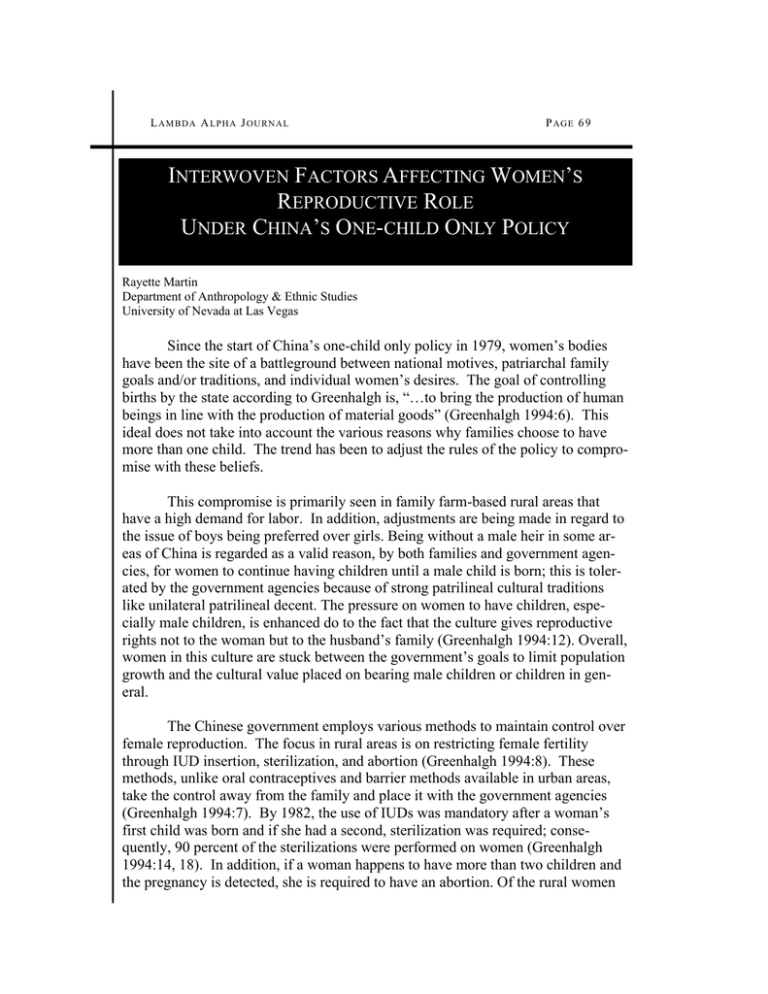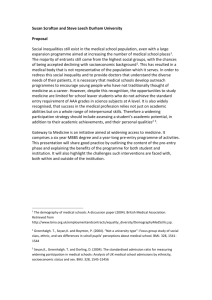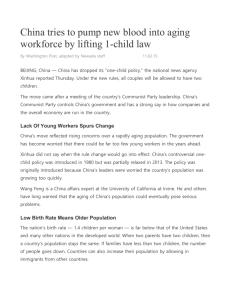I F A W
advertisement

L A M B DA A LPH A J O U RN A L PAGE 69 INTERWOVEN FACTORS AFFECTING WOMEN’S REPRODUCTIVE ROLE UNDER CHINA’S ONE-CHILD ONLY POLICY Rayette Martin Department of Anthropology & Ethnic Studies University of Nevada at Las Vegas Since the start of China’s one-child only policy in 1979, women’s bodies have been the site of a battleground between national motives, patriarchal family goals and/or traditions, and individual women’s desires. The goal of controlling births by the state according to Greenhalgh is, “…to bring the production of human beings in line with the production of material goods” (Greenhalgh 1994:6). This ideal does not take into account the various reasons why families choose to have more than one child. The trend has been to adjust the rules of the policy to compromise with these beliefs. This compromise is primarily seen in family farm-based rural areas that have a high demand for labor. In addition, adjustments are being made in regard to the issue of boys being preferred over girls. Being without a male heir in some areas of China is regarded as a valid reason, by both families and government agencies, for women to continue having children until a male child is born; this is tolerated by the government agencies because of strong patrilineal cultural traditions like unilateral patrilineal decent. The pressure on women to have children, especially male children, is enhanced do to the fact that the culture gives reproductive rights not to the woman but to the husband’s family (Greenhalgh 1994:12). Overall, women in this culture are stuck between the government’s goals to limit population growth and the cultural value placed on bearing male children or children in general. The Chinese government employs various methods to maintain control over female reproduction. The focus in rural areas is on restricting female fertility through IUD insertion, sterilization, and abortion (Greenhalgh 1994:8). These methods, unlike oral contraceptives and barrier methods available in urban areas, take the control away from the family and place it with the government agencies (Greenhalgh 1994:7). By 1982, the use of IUDs was mandatory after a woman’s first child was born and if she had a second, sterilization was required; consequently, 90 percent of the sterilizations were performed on women (Greenhalgh 1994:14, 18). In addition, if a woman happens to have more than two children and the pregnancy is detected, she is required to have an abortion. Of the rural women PAGE 70 V O LU M E 3 6 , 2 0 0 6 Greenhalgh studied, one in four had received an abortion and one in eight had received an abortion during the second or third trimester (Greenhalgh 1994:8, 23). This indicates that the women in the rural areas where Greenhalgh conducted her study were frequently having more than two children. In theory, the families adhering to the one-child only policy are given incentives to maintain their commitment to the policy or they are penalized for exceeding the one-child quota. However, these incentives and penalties vary between urban and rural areas. According to Wasserstrom, the incentives include a monetary bonus in urban areas of 40 yuan and 5 yuan in rural areas. In addition, the only child receives favored educational opportunities and preferential health care. The families also receive the better land and/or living space. It is believed that these incentives could account for up to 25 to 33 percent of a family’s total income (Wasserstrom 1984:352). The consequences for exceeding the one-child quota include the possibility of the government withholding up to 10 percent of the family’s income and subsequent children may loose their rations for certain items (Wasserstrom 1984:353). These incentives explain why the program is more popular among the poorer urban families. As Kaufman et. al. pointed out, those with below average income were more likely to take the one child pledge; they account for roughly half of the pledge takers with the average income families and above average income families splitting the rest at roughly twenty-five percent each (Kaufman et. al. 1989:718). It is obvious that the one-child only policy has consequences for women’s control over reproduction; however, the indication of the compliance being primarily by those with below average income indicates that the policy is less than desired by those with the means to oppose the policy. The women who do not comply with the policy use a variety of methods to get around the seemingly fool-proof birth control methods enforced by the government. According to Greenhalgh, the 1987 official figures put contraceptive compliance at seventy-seven percent for all married women of reproductive age in China (Greenhalgh 1994:14). However, these figures may not be accurate because the people responsible for reporting findings are held accountable if the levels of compliance are low and women may not be checked after being given contraceptives to make sure they are still complying. An example of resistance that is used by the women is that often-times women remove their IUD shortly after its implantation. They also use various explanations as to why it was missing during physical exams such as it just fell out (Greenhalgh 1984:17, Wasserstrom 1984:356). Resistance through removal or avoidance of the birth control measures is seen in the fact that in the 1980s, eighty-five percent of women with one child were not using the IUD and seventy-five percent were not sterilized after L A M B DA A LPH A J O U RN A L PAGE 71 having two children (Greenhalgh 1994:19). These numbers are quite large despite the incentives offered, the possible penalties, and the state-regulated birth control measures like the IUD and sterilization campaigns. One of the main reasons why people continue having children is the preference for male children. Women will continue having children until they get a son. According to Greenhalgh, those with at least one son were two times more likely to be following the rules than those with only daughters (Greenhalgh 1994:19). This is exemplified in this quote from a Chinese woman: “Because in our village, if a woman does not have a son, she suffers from discrimination and mistreatment which is even greater in its bitterness than the risk of our lives!” (Wasserstrom 1984:350). This preference for male children is rooted in the residence and decent pattern of the culture, the gender related economic contributions, the lack of government sponsored elder care, and the need for family labor in rural farms. The Chinese practice patrilineal decent placing the focus on the male heir to carry on the family name. China has also recently seen a resurgence of ancestor worship making the families’ connection between the ancestors and the continuation of the lineage a combined force for the preferential choice of sons (Wasserstrom 1984:349). Patrilocality customs of Chinese culture also places emphasis on male children because when daughters marry they join their husband’s family and no longer contribute to the natal family. Sons, however, will stay with the natal family and bring to it the contributions of his wife and child or children, thus, making it economically important to have a son or sons rather than only a daughter or daughters. In addition to sons bringing in wives and children, they are also the ones who become responsible for caring for their parents when they are no longer able to care for themselves (Wasserstrom 1984:350). This is a tremendous stress for a family without a son or sons because there is no program to ensure that parents will be cared for and their daughter’s obligation after marriage is to her husband’s family. Thus, those without sons are left vulnerable to extremely unpleasant circumstances in old age or if they are ever unable to care for themselves due to unforeseen events like disease or injury. Another factor contributing to the preference for male children is that they provide the labor in the rural family farms (Kaufman et. all 1989:708). As Wasserstrom explains, “a family’s economic position under the system depends on the size and strength of its labor force” (Wasserstrom 1984:369). This is seen in the more relaxed regulation of the policy in the rural areas compared to the urban areas (Kaufman et. all 1989:709). In the farm-based economic villages, it is also important to have the security of more than one child in case one child happens to PAGE 72 V O LU M E 3 6 , 2 0 0 6 die (Greenhalgh 1994:11). The pursuit for at least one son is fueled by the combination of cultural factors discussed above and is one of the reasons for resistance to the one-child only policy. Due to the desire for male children, and often times at the expense of female children, families have had to take alternative measures to ensure they will be able to have a male child. Methods to rid one’s self from a female child include abortion, infanticide, and adoption. The only way to know if the fetus is female is through technological advances utilized by those who conduct the prenatal examinations; even though the health care practitioners are not supposed to inform the parents of the sex of the child, it is known that one can use bribes to get the information necessary to make the decision whether or not to abort the fetus (Handwerker 1998:183-184). Infanticide is an alternative method of riding one’s self from a female child. According to Wasserstrom, “in a single Huaiyuan production brigade more than 40 instances of female infanticide reportedly occurred during 1980 and 1981…” (Wasserstrom 1984:358). Adoption is a possible solution; however, it is not supported by the one-child only policy (Greenhalgh 1994:15) and must be done in secret. There are surprising discrepancies in birth records which support this preference for male children at the expense of female children. For example, “in Longkang there were only 86 girls to 125 boys born according to a survey by the Anhui Women’s Federation conducted April 7th, 1983” (Wasserstrom 1984:358). In contrast to the women doing all they can to have a male child, some women, primarily upper socioeconomic urban women, are choosing not to have any children. According to Handwerker, of the people without one child, over 73 percent are intellectuals or cadres (Handwerker 1998:198). These childless people choose this life for a number of reasons. Ironically, China does not support this seemingly exuberant over conformity to the one-child only policy. As one woman put it, “the one child policy is really the ‘you must have one-child policy’” (Handwerker 1998:183). Women who choose to remain childless face consequences such as lack of benefits that those with one child receive, including, better housing and monetary bonuses (Handwerker 1998:183). Unsurprisingly, women who chose not to have children are stigmatized as being unnatural (Handwerker 1998:195). The Chinese medical doctors, even those who practice Western biomedicine, believe that women naturally want to have children and if they say that they do not, it is only because they cannot have children of their own (Handwerker 1998: 196-197). Female elites are encouraged to reproduce during a time of population control efforts because of the fear that if the only new Chinese are being born from the common class it would result in “the denigration of the Chinese state” (Handwerker 1998:199). As one man put it L A M B DA A LPH A J O U RN A L PAGE 73 while talking to a well off couple, “if you don’t give birth you will bring a disadvantage to the development of a high quality population” (Handwerker 1998:199). The encouragement for women to produce at least one child is also seen in the trouble infertile women go through. First of all, the infertile woman is under pressure to fulfill her female gender role as a mother. One woman explains, “I want a child because if you don’t have a child you are different from everyone else – everyone else has a child” (Handwerker 1998:183). The pressure to have a child, primarily, a male child, also comes from the husband, the mother-in-law, and one’s peers (Handwerker 1998:182). Infertility is viewed as a woman’s issue even if it is her husband who happens to be infertile (Handwerker 1998:184, 189). Therefore, it is the woman who is stigmatized and seen as the source of the problem. Both medical fields, traditional and biomedical, view infertility as a consequence of female action. According to the biomedical field, infertility is a “disorder of civilization and modern living” (Handwerker 1998:192). Similarly, the more traditional Chinese medical practice views infertility as “a consequence of exhausted virtue…a punishment for moral and ritual transgressions” (Handwerker 1998:186). Through both of these explanations of childlessness, it is the woman who made herself that way. It is no wonder why infertile women are treated poorly by others, including beatings by their husbands and being subject to divorce (Handwerker 1998:192). Overall, all women in China are affected by the one-child only policy. Regardless of women’s desires to have or not to have children, their reproductive role is affected by ideology, patrilineal decent, patrilocality, economics, gender roles, and the medicalization of reproduction. Women, although trying to exert agency over the issue, are being pushed and pulled by a variety of intertwined factors. The original purpose of the one-child only policy was to restrict population growth in order to match the population more adequately with the material growth; however, as we have seen, it is not that simple. Unfortunately, it seems like the women are the ones who are ultimately paying the price for a political policy implemented with good intentions. Bibliography Ginsburg, Faye and Rayna Rapp 1991 The Politics of Reproduction. Annual Review of Anthropology. 20:311343. PAGE 74 V O LU M E 3 6 , 2 0 0 6 Greenhalgh, Susan 1994 Controlling Births and Bodies in Village China. American Ethnologist 21 (1):3-30. Handwerker, Lisa 1998 The Consequences of Modernity for Childless Women in China: Medicalization and Resistance. In Pragmatic women and body politic. Cambridge Studies in Medical Anthropology No. 5. Margaret Lock and Patricia A. Kaufert, eds. Pp.178-205. Cambridge: Cambridge University Press. Kaufman, Joan with Zhang Zhirong, Qiao Zinjian, and Zang Yang. 1989 Family Planning Policy and Practice in China: A Study of Four Rural Counties. Population and Development Review 15(4):707-729. Rapp, Rayna 1993 Accounting for Amniocentesis. In Knowledge, Power, and Practice: TheAnthropology of Medicine and Everyday Life. Comparative studies of healthcare systems and medical care No. 6. Shirley Lindenbaum and Margaret Lock eds. Pp. 55-78. Berkeley: University of California Press. Wasserstrom, Jeffery 1984 Resistance to the One-Child Family. Modern China 10(3):345-374.



